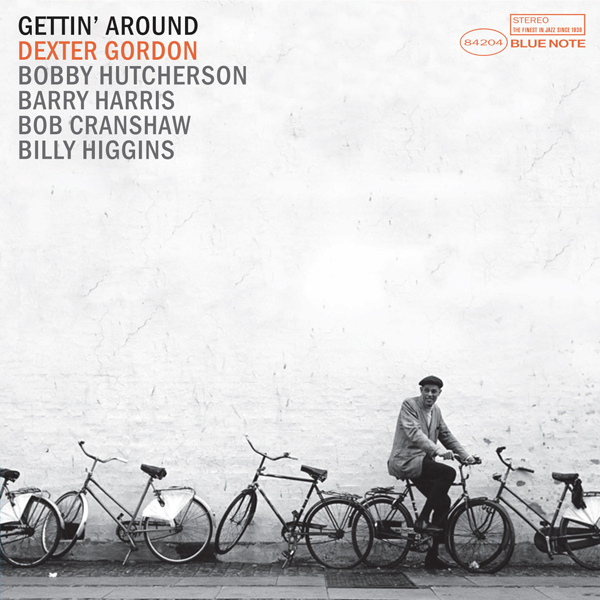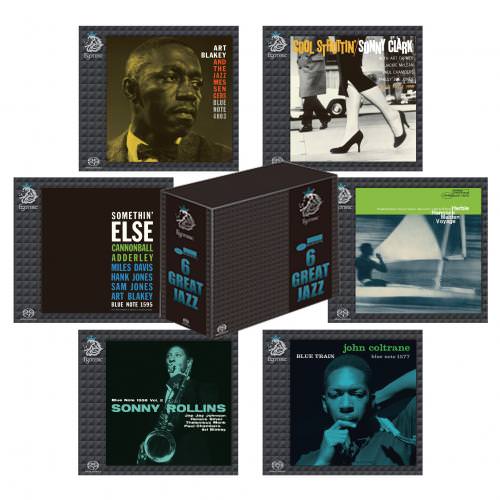
Dexter Gordon – Gettin’ Around (1965/2015)
FLAC (tracks) 24-bit/192 kHz | Time – 00:41:19 minutes | 1,64 GB | Genre: Jazz
Studio Master, Official Digital Download | Source:Qobuz | Front cover
Label: © Blue Note Records | Recorded: May 28 & 29, 1965 at the Van Gelder Studio, Englewood Cliffs, New Jersey.
Dexter Gordon’s mid-’60s period living in Europe also meant coming back to the U.S. for the occasional recording session. His teaming with Bobby Hutcherson was intriguing in that the vibraphonist was marking his territory as a maverick and challenging improviser. Here the two principals prove compatible in that they have a shared sense of how to create sheer beauty in a post-bop world. Add the brilliant Barry Harris to this mix, and that world is fortunate enough to hear these grand masters at their creative peak, stoked by equally extraordinary sidemen like bassist Bob Cranshaw and drummer Billy Higgins, all on loan from Lee Morgan’s hitmaking combo. The subtle manner in which Gordon plays melodies or caresses the most recognizable standard has always superseded his ability to ramble through rough-and-tumble bebop. It’s hard to resist how Gordon massages the light and sweet bossa nova “Manha de Carnaval” hand in hand with Hutcherson, the heartfelt way “Who Can I Turn To?” or “Everybody’s Somebody’s Fool” is turned into a personalized statement, or how the co-leaders take Frank Foster’s Count Basie staple, “Shiny Stockings,” beyond a classic and into immortal territory. Where Gordon and Hutcherson’s true strength lies is in their ability to listen and balance their sound into a unified whole beyond any other tenor sax-vibraphone combination you might care to name, unless it’s Hutch’s partnership in the ensuing years with Harold Land. Picking up on a Sonny Rollins idea, “Heartaches” is a loping cowboy-type swinger with some lustrous comping from Hutcherson and Harris, while the light, cat-prancing “Le Coiffeur” is the highlight among highlights, a stealth calypso with Gordon’s deftly rendered staccato notation. One has to listen closer to the pianist on this date, as he buoys the others without demanding equal space, but he is just as reverberant. While this is not Gordon’s ultimate hard bop date, it is reflective of his cooling out in Europe, adopting a tonal emphasis more under the surface than in your face. It’s not essential, but quite enjoyable, and does mark a turning point in his illustrious career. -Michael G. Nastos, AllMusic
An arterial link between Lester Young and the hard bop tenor saxophonists of the late ’50s and early ’60s, Dexter Gordon’s brilliance and significance are today remembered mostly as an afterthought. Partly this is Gordon’s own fault: after his prolific vanguard activities of the ’40s, the ’50s were for him a wasteland of heroin addiction, with few recording sessions or landmark live appearances. He’s off the page of most jazz chronicles from the period.
Happily, though, Gordon’s most on-fire recordings survive. Gettin’ Around was made during his unexpected and magnificent renaissance on Blue Note in the mid ’60s. Its inclusion in the Rudy Van Gelder remaster programme is great news for anyone who enjoys the eternal verities of American jazz—and who relishes in particular the tenor saxophonist as unruly sonic gunslinger.
Gordon’s playing was an extension of his six and a half foot stature. His sound was big, his notes were big, and his lyricism was rough-hewn. His influences were one part Young and one part Charlie Parker. From Parker he took a hard and deliberate tone, vibrato-less except in the most intimate moments, and from Young he took a horizontal approach to improvisation, though gruffer and more bass register-rooted. Drop all that into the studio along with the rhythm section that helped make Lee Morgan’s The Sidewinder as bad-ass as it was, stir in rising vibraphone star Bobby Hutcherson, and you have real voodou.
Most of the album is mid to up-tempo, hot, broad, careless, exuberant, and vigorously swinging. The pieces range from the wittily codified bossa nova “Manha De Carnaval” to the booting romps “Heartaches” and “Shiny Stockings” and the ten-minute blues jam “Flick Of A Trick.” Gordon’s only original, the pretty and balletic “Le Coiffeur,” is clearly influenced by French chanson—by the time this album was recorded, Gordon had been resident in Europe for three years—but the only real ballad is “Who Can I Turn To” (check the vibrato-as-foreplay). The leader takes most of the solo space, but Harris and Hutcherson each get chances to shine. Harris’ solo on “Le Coiffeur” is lovely, as are Hutcherson’s pre-Leary but trippy sonics on “Flick Of A Trick.”
Along with ’63’s Our Man In Paris and the original ’61 comeback album Doin’ Alright, this is one of three immortal works in the Gordon canon. -Chris May, All About Jazz
Tracklist:
1 Manha De Carnaval 8:26
2 Who Can I Turn To (When Nobody Needs Me) 5:15
3 Heartaches 7:46
4 Shiny Stockings 6:18
5 Everybody’s Somebody’s Fool 6:45
6 Le Coiffeur 7:01
Personnel:
Dexter Gordon – tenor saxophone
Bobby Hutcherson – vibes
Barry Harris – piano
Bob Cranshaw – bass
Billy Higgins – drums
Download:
mqs.link_DexterGrdnGettinArund196519224.part1.rar
mqs.link_DexterGrdnGettinArund196519224.part2.rar




















![Dexter Gordon - Clubhouse (1979/2015) [Qobuz FLAC 24bit/192kHz] Dexter Gordon - Clubhouse (1979/2015) [Qobuz FLAC 24bit/192kHz]](https://getimg.link/images/imgimgimg/uploads/2017/01/VYy2GnP.jpg)
![McCoy Tyner - Time For Tyner (1968/2015) [Qobuz FLAC 24bit/192kHz] McCoy Tyner - Time For Tyner (1968/2015) [Qobuz FLAC 24bit/192kHz]](https://getimg.link/images/imgimgimg/uploads/2016/04/T8Lt0Hc.jpg)
![Bobby Hutcherson - Total Eclipse (1968/2013) [HDTracks FLAC 24bit/192kHz] Bobby Hutcherson - Total Eclipse (1968/2013) [HDTracks FLAC 24bit/192kHz]](https://getimg.link/images/imgimgimg/uploads/2016/04/1nxsCTg.jpg)

![Dexter Gordon - One Flight Up (1964/2015) [Qobuz FLAC 24bit/192kHz] Dexter Gordon - One Flight Up (1964/2015) [Qobuz FLAC 24bit/192kHz]](https://getimg.link/images/imgimgimg/uploads/2017/01/BgFHZu0.jpg)
![Dexter Gordon - Dexter Gordon Plays 1955 (2021) [FLAC 24bit/96kHz] Dexter Gordon - Dexter Gordon Plays 1955 (2021) [FLAC 24bit/96kHz]](https://getimg.link/images/imgimgimg/uploads/2021/12/fCjM4o9.jpg)
![Bobby Hutcherson - Components (1965/2015) [HighResAudio FLAC 24bit/192kHz] Bobby Hutcherson - Components (1965/2015) [HighResAudio FLAC 24bit/192kHz]](https://getimg.link/images/imgimgimg/uploads/2016/04/Wf1vDmt.jpg)


![Bobby Hutcherson - Happenings (1966/2013) [HDTracks FLAC 24bit/192kHz] Bobby Hutcherson - Happenings (1966/2013) [HDTracks FLAC 24bit/192kHz]](https://getimg.link/images/imgimgimg/uploads/2016/04/puznpxf.jpg)
![Jackie McLean - Destination… Out! (1964/2014) [HDTracks FLAC 24bit/192kHz] Jackie McLean - Destination… Out! (1964/2014) [HDTracks FLAC 24bit/192kHz]](https://getimg.link/images/imgimgimg/uploads/2017/06/MU5iG2C.jpg)
![Big John Patton - Let Em Roll (1965/2016) [Qobuz 24-192] Big John Patton - Let Em Roll (1965/2016) [Qobuz 24-192]](https://getimg.link/images/imgimgimg/uploads/2017/05/GcRZZhM.jpg)
![Dexter Gordon - Dexter Calling (1961/2015) [Qobuz FLAC 24bit/192kHz] Dexter Gordon - Dexter Calling (1961/2015) [Qobuz FLAC 24bit/192kHz]](https://getimg.link/images/imgimgimg/uploads/2019/07/wMWsdiY.jpg)
![Dexter Gordon - Doin’ Allright (1961/2015) [Qobuz FLAC 24bit/192kHz] Dexter Gordon - Doin’ Allright (1961/2015) [Qobuz FLAC 24bit/192kHz]](https://getimg.link/images/imgimgimg/uploads/2017/01/7HMqiMF.jpg)
![Dexter Gordon - Sophisticated Giant (1977) [FLAC 24bit/192kHz] Dexter Gordon - Sophisticated Giant (1977) [FLAC 24bit/192kHz]](https://imghd.xyz/images/2022/01/16/bj647sqw703yc_600.jpg)